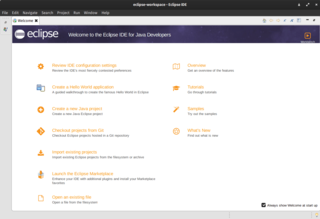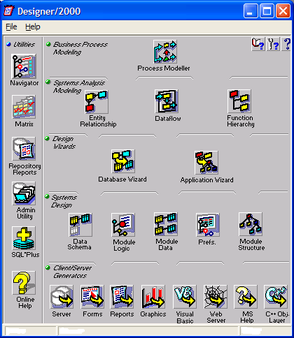An integrated development environment (IDE) is a software application that provides comprehensive facilities for software development. An IDE normally consists of at least a source-code editor, build automation tools, and a debugger. Some IDEs, such as NetBeans, JDoodle and Eclipse, contain the necessary compiler, interpreter, or both; others, such as SharpDevelop and Lazarus, do not.

Eclipse is an integrated development environment (IDE) used in computer programming. It contains a base workspace and an extensible plug-in system for customizing the environment. It is the second-most-popular IDE for Java development, and, until 2016, was the most popular. Eclipse is written mostly in Java and its primary use is for developing Java applications, but it may also be used to develop applications in other programming languages via plug-ins, including Ada, ABAP, C, C++, C#, Clojure, COBOL, D, Erlang, Fortran, Groovy, Haskell, JavaScript, Julia, Lasso, Lua, NATURAL, Perl, PHP, Prolog, Python, R, Ruby, Rust, Scala, and Scheme. It can also be used to develop documents with LaTeX and packages for the software Mathematica. Development environments include the Eclipse Java development tools (JDT) for Java and Scala, Eclipse CDT for C/C++, and Eclipse PDT for PHP, among others.
Model Driven Architecture (MDA) is a software design approach for the development of software systems. It provides a set of guidelines for the structuring of specifications, which are expressed as models. Model Driven Architecture is a kind of domain engineering, and supports model-driven engineering of software systems. It was launched by the Object Management Group (OMG) in 2001.
Round-trip engineering (RTE) in the context of model-driven architecture is a functionality of software development tools that synchronizes two or more related software artifacts, such as, source code, models, configuration files, documentation, etc. between each other. The need for round-trip engineering arises when the same information is present in multiple artifacts and when an inconsistency may arise in case some artifacts are updated. For example, some piece of information was added to/changed in only one artifact and, as a result, it became missing in/inconsistent with the other artifacts.
Astah, formerly known as JUDE, is a UML modeling tool created by Japanese company Change Vision. JUDE received the "Software Product Of The Year 2006" prize, established by Information-Technology Promotion Agency in Japan.
A UML tool is a software application that supports some or all of the notation and semantics associated with the Unified Modeling Language (UML), which is the industry standard general-purpose modeling language for software engineering.

Uniface is a low-code development and deployment platform for enterprise applications that can run in a large range of runtime environments, including mobile, mainframe, web, Service-oriented architecture (SOA), Windows, Java EE, and .NET. Uniface is used to create mission-critical applications.

StarUML is a software engineering tool for system modeling using the Unified Modeling Language, as well as Systems Modeling Language, and classical modeling notations. It is published by MKLabs and is available on Windows, Linux and MacOS.

Unicom System Architect is an enterprise architecture tool that is used by the business and technology departments of corporations and government agencies to model their business operations and the systems, applications, and databases that support them. System Architect is used to build architectures using various frameworks including TOGAF, ArchiMate, DoDAF, MODAF, NAF and standard method notations such as sysML, UML, BPMN, and relational data modeling. System Architect is developed by UNICOM Systems, a division of UNICOM Global, a United States-based company.
Oracle Spatial and Graph, formerly Oracle Spatial, is a free option component of the Oracle Database. The spatial features in Oracle Spatial and Graph aid users in managing geographic and location-data in a native type within an Oracle database, potentially supporting a wide range of applications — from automated mapping, facilities management, and geographic information systems (AM/FM/GIS), to wireless location services and location-enabled e-business. The graph features in Oracle Spatial and Graph include Oracle Network Data Model (NDM) graphs used in traditional network applications in major transportation, telcos, utilities and energy organizations and RDF semantic graphs used in social networks and social interactions and in linking disparate data sets to address requirements from the research, health sciences, finance, media and intelligence communities.

Oracle Designer was Oracle's CASE tool for designing an information system and generating it. After generating the information system one is able to edit the generated code with Oracle Developer Suite.
Azure DevOps Server is a Microsoft product that provides version control, reporting, requirements management, project management, automated builds, testing and release management capabilities. It covers the entire application lifecycle and enables DevOps capabilities. Azure DevOps can be used as a back-end to numerous integrated development environments (IDEs) but is tailored for Microsoft Visual Studio and Eclipse on all platforms.
Domain-driven design (DDD) is a major software design approach, focusing on modeling software to match a domain according to input from that domain's experts.
An embedded database system is a database management system (DBMS) which is tightly integrated with an application software; it is embedded in the application. It is a broad technology category that includes:
The RISE Editor is a free information modeling tool for information system development based on model driven development. Functionality includes automatic interface composition, database generation and updates, data insertion, programming interface publishing and web service generation. The modeling takes place in Entity Relationship Diagrams (ERD). The layout for these diagrams can be changed to Relational Database or Unified Modeling Language (UML), the functionality stays the same though.

db4o was an embeddable open-source object database for Java and .NET developers. It was developed, commercially licensed and supported by Actian. In October 2014, Actian declined to continue to actively pursue and promote the commercial db4o product offering for new customers.

Sparx Systems Enterprise Architect is a visual modeling and design tool based on the OMG UML. The platform supports: the design and construction of software systems; modeling business processes; and modeling industry based domains. It is used by businesses and organizations to not only model the architecture of their systems, but to process the implementation of these models across the full application development life-cycle.
Imixs Workflow is an Open-Source-Project, providing technologies for building Business Process Management solutions. The project focus on human based workflows used to execute and control workflows in organisations and enterprises. In difference to task-oriented workflow engines, which focus on automated program flow control (tasks), Imixs Workflow is a representative of an event-based workflow engine. Here, the engine controls the status of a process instance within a defined state-diagram. By entering an event, the state of a process instance can be abandoned or changed. In human-centric workflow engines, events usually occur by an interaction of the actor with the system, for example by approving or rejecting a business transaction. They can also be triggered by scheduled events. An example of this is an escalation of an unfinished task.







